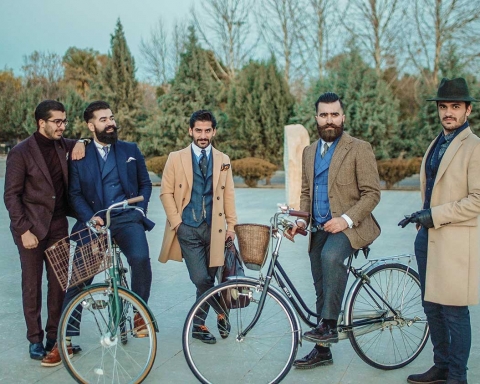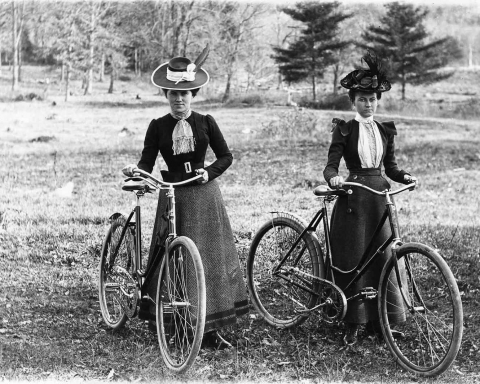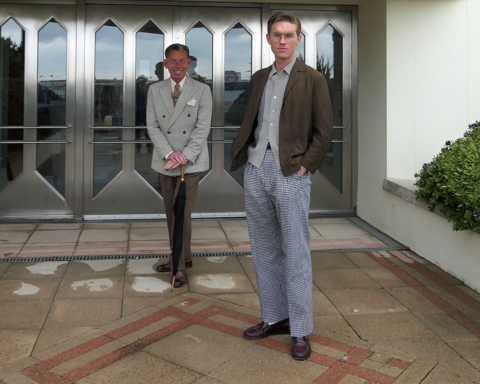G Robert Ogilvy, a North American citizen, unashamedly passes judgement on the manner in which the people of today clothe themselves.
A few weeks ago I was sitting in my car in a parking lot outside a drugstore – I had just read a trend piece in the New York Times lifestyle section and found myself suddenly in need of Alka-Seltzer – when I noticed a man pacing the sidewalk. Something about him drew my attention. He was wearing a double-vented beige sports coat and, as he turned, I suddenly noticed something poking through the jacket’s right vent: the butt of a semi-automatic pistol. The man was clearly some sort of law enforcement officer.
As I watched the man get into a black sedan and drive away, I pondered the choice of a double vent. Single-vent would be better for concealment, but some day that man may have to draw his gun quickly and the extra split second afforded by his double-vent might save his life. Strange, I thought, how details matter.
I never thought that I, of all people, would be writing an essay about clothing and style. I am not a fashion expert, nor do I want to be, and if you were to tell me ten years ago that I would one day write with any authority on the subject, I would have thought it more likely I would one day be an astronaut for the Tibetan space program. So the fact that I – someone who, as a boy, was once convinced by a retail clerk that cargo shorts were the future – am now writing this shows you just how bad things have got. The barbarians are at the gate, we’re besieged and about to be overrun, and I’m giving orders only because all the ranking officers are already dead.
The barbarians are at the gate, we’re about to be overrun, and I’m giving orders only because all the ranking officers are already dead
I say barbarians. Since the day I saw someone wearing sweatpants to court I’ve had no doubt that we, as a society, have gone too far. No sphere of North American life – not popular music, not the media, not our “higher” education system, – has escaped the slow deterioration of cultural entropy. But it is clothing, the most tangible outward symbol of our collective tastes and values and sensibilities as a society, which has been afflicted worst of all.

It defies logic. People who’ve clearly never been to the gym only ever wear gym clothing. People who’ve never even cut their own grass dress like migrant farm workers. Women wear push-up bras to funerals. Men seldom wear neckties, and the rare occasions that they do, they buy them from Donald Trump.
What is the cause of this all-pervasive erosion in societal standards of decency and taste? Much of it is the product of a long-term trend toward casualization of dress that started in the late 1960s and continued, slowly, until the cool, laid-back office managers of the 1990s delivered the final coup de grâce by effectively making every day Casual Friday. The arc of the cultural universe is long but it bends toward laziness.
Clothing which was once considered underwear – tank tops, leggings, pajama bottoms – is now considered appropriate clothing to wear while grocery shopping or going to the bank. You know how exhausting it is to button a shirt.
“You’re wearing leather shoes,” someone said to me recently. “What’s the occasion?” The occasion is that I’m an adult.
Social standards and aesthetic sensibilities typically diffuse down from the most educated and affluent classes in society, which makes the current lapse in taste – at a time when society is overloaded with more educated professionals than all of previous history – so perplexing. It is, of course, perfectly sensible that someone who works with their hands for a living wears practical clothing which can be dirtied. When, however, architects and professors and bureaucrats “dress down”, it isn’t a sign of humility but of arrogance.

It starts at the top – and the top is rotten from the inside. Visit any allegedly elite North American university and you’ll see that it’s often possible to identify someone’s political inclinations by their clothing. The apathetic bourgeois merely throw a name-brand jacket over a name-brand hoodie over a pair of name-brand sweatpants, as if to prove how invested they are in not caring about anything. The hardcore leftists (many of whom actually come from wealthy backgrounds, or at least backgrounds wealthy enough that they can spend five or six years studying ways to fight capitalism) dress in borderline rags: an unpersuasive attempt to convince people that they’re oppressed. For them, dressing like slobs is nothing short of a political commitment.
Another reason that clothing standards have declined so dramatically is because they’ve been allowed to. The ethos of our age, unfortunately, is tepid, morally-flaccid non-judgmentalism, and it’s hard to prevent people from wearing transparent booty shorts to the bank if you’re frightened to come across as judgmental. Today you can say or do practically anything – anything, that is, but pass judgment. Shaming? That’s practically medieval.
Here are some rules

None are especially original – what is needed today is forcefully-stated common sense
1. Dress for the job you want, not the job you have
How you present yourself says a lot about your values and ambitions in life – or lack of. Executives dress like executives, so people who hope one day to become executives dress like executives. People who will always take orders from others dress like schmucks.
2. Dress for the body you have, not the body you want
Before I’m accused of promoting vicious body image anxiety, I want to assert that that’s the exact opposite of my intention. All I’m saying is: dress in ways that flatter you.
Similarly, I want to state that this rule, like the others, applies to everyone, regardless of gender, and that the governing principle remains the golden rule: Do unto others…
For example, though I could, if I so pleased, mow my lawn in a pair of Speedos, I do not – despite the presumed aerodynamic benefits – because I know that no one desires that image burned into their retinas: not me, who can’t afford to repair any shattered mirrors; not my friends or family, who’ve suffered enough; not my elderly neighbors with weak hearts; not even women who date me, most of whom already wear thick prescriptions; and probably not even the Speedo corporation itself, whose profit margins would surely be permanently damaged by my enthusiastic adoption of its brand identity.
In short, I recognize the realities of this cruel world in which Speedos shall forever remain the exclusive purview of bronzed Mediterranean demigods, and I submit to them. Is that unfair? Perhaps. Is life unfair? Yes.
3. Less is more, and more is less
I’m often shocked by the things – or lack of things – that I see people wearing, and I’m speaking as a straight male who, logically, ought to be delighted by the fact that it’s now apparently acceptable for city women to wear outfits that would be considered obscene on a beach in the south of France. Again, before I’m accused of being some sort of misogynistic reactionary who wants to return to the days when the word “pregnant” couldn’t be said on television: I’m not. I’m just asking for something to be left to the imagination.
4. Dress your age
“You’re wearing leather shoes,” someone said to me recently. “What’s the occasion?” The occasion is that I’m an adult.
5. Laziness is not a virtue
Form ought to follow function , which is why many rightfully iconic garments were originally worn by soldiers (trench coats), working people (fishermen’s sweaters), or sportsmen (shooting jackets, rugby shirts). But some sort of line must be drawn. Comfort is important, but so is propriety, and shameless laziness should never be rewarded.
6. Fussiness is not necessarily a vice
Caring about clothes might strike the man on the street as silly. Fortunately, he is usually wrong. The irony of all of this, I suspect, is that not even those who convince themselves they enjoy dressing in the ways I’ve criticized here actually do. What is the major appeal of shows like Mad Men or Masters of Sex, if not aesthetic? Today we’re liberated to wear anything we could possibly want, yet what we yearn for, more than anything, is to watch men on TV sweating through wool suits.









